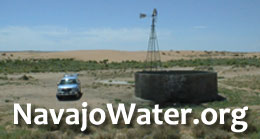Brazil’s Uranium Film Festival sent out this press release highlighting The Return of Navajo Boy’s screening in Rio de Janeiro, Sao Paulo, and all across Brazil on a traveling tour this summer.
Urânio em Movi(e)mento – The 1st International Festival of Films on Nuclear Energy, Rio de Janeiro May 16th to 28th, 2011
The Movie “The Return of Navajo Boy” USA, 2008, 57 min, by Director Jeff Spitz is one of eight best films of the 1st International Festival of Films on Nuclear Energy in Rio de Janeiro.
The entire world knows John Ford and John Wayne and their legendary films of the Wild West. The documentary of Jeff Spitz connects these important stars of Hollywood with the suffer of the indigenes people of the southwest of USA, the Navajo (Diné), who suffers until today because of uranium mining, which took place in their territory and used miss-informed Navajo people as cheap uranium miners to create the first atomic bombs!
A jury composed of scientists, journalists, producers and film experts has selected “The Return of Navajo Boy” together with seven other documentaries and movies among 34 for the official screenings selected films to compete in the awards for the best short and the best feature film of the festival.
The other selected films are:
Into Eternity, Denmark, 2009, 75 min. by Director Michael Madsen. The film questions whether a safe deposit of radioactive waste from nuclear plants is possible or not? Who will protect the extremely radioactive waste for at least a hundred thousand years?
Beating the Bomb, United Kingdom, 2010, 71 min, by Director Wolfgang Matt and Meera Patel. It is an intelligent, very good produced film about the peace movement in Britain against the atomic bomb.
Chernobyl, une histoire naturelle? (Chernobyl, a natural history?), France, 2010, 90 min, by Director Luc Riolon. The film shows the nuclear accident of April 26, 1986 in the Ukraine and what happened with nature until today. Zoologists and radioecologists are making surprising discoveries.
Om bergen faller sönder (Under the surface), Sweden, 2010, 35 min, by Director Klara Sager. It is a simple, but clear film about a local community and indigenous population in northern Sweden and an international mining company prospecting for Uranium. The local people are afraid and against uranium prospecting and against uranium mining, because they depend on the local natural resources like the Reindeers.
Climate of Hope, Australia, 2007, 30 min, by Directors’ Scott Ludlam and Jose Garcia. This film shows the whole nuclear energy cycle, from mining uranium to the nuclear plant and its relation to the greenhouse effect. It is a very interesting film perfect for schools and universities. It says: Nuclear energy is producing a lot of CO2 and for that will not save the world against global warming!
A film, which became even more important during the last 4 weeks is a documentary made by the Costa Rican filmmaker Pablo Ortega. Uranium 238: La Bomba del Pentagon Sucia (The Dirty Bomb the Pentagon), 2009, 28 min. The film talks about a nuclear issue that is little known in the world: rockets and bombs with depleted uranium that are radioactive and used by the USA in international wars like Iraq and very likely during the current war in Libya. The consequences of the use of these bombs are terrible for the local population and the soldiers themselves who make use of them. Worth mentioning that last April, the government of Costa Rica became the second government of the world to ban this type of ammunition. Uranium 238 is a Brazilian premiere.
A short documentary made 2003 in Brazil by Director Luiz Eduardo Jorge is the last finalist: Césio 137 – O brilho da morte (Cesium – The brightness of death): “It is a striking film”, says Professor João Luiz Leocádio. This film about the Chernobyl of Brazil, a nuclear accident that happened 1987 in the city of Goiânia, questions the competence of the national Brazilian authorities on nuclear safety. “The film reveals that beyond the question of nuclear power plants like Angra 1 and 2, Brazil and the world must also discuss the question of the nuclear waste from hospitals and radiology centres. Everybody could be affected!” says environmental journalist Norbert G. Suchanek and General Director of the Uranium Film Festival.
The judges are: John Louis Leocádio, Professor of Film & Video, University Federal Fluminense (Rio de Janeiro), Dawid Bartelt, Director of the Heinrich Boell Foundation, Brazil Office; Angelo Antonio Duarte, journalist and professor of Film and Audio of the Technical School Adolpho Bloch – FAETEC, Marco Fadiga, Producer of Caju Filmes and Technical Director of the 1st Uranium Film Festival, Norbert G. Suchanek, environmental and human rights Journalist, Filmmaker and General Director 1st Uranium Film Festival.














Leave a Reply
You must be logged in to post a comment.